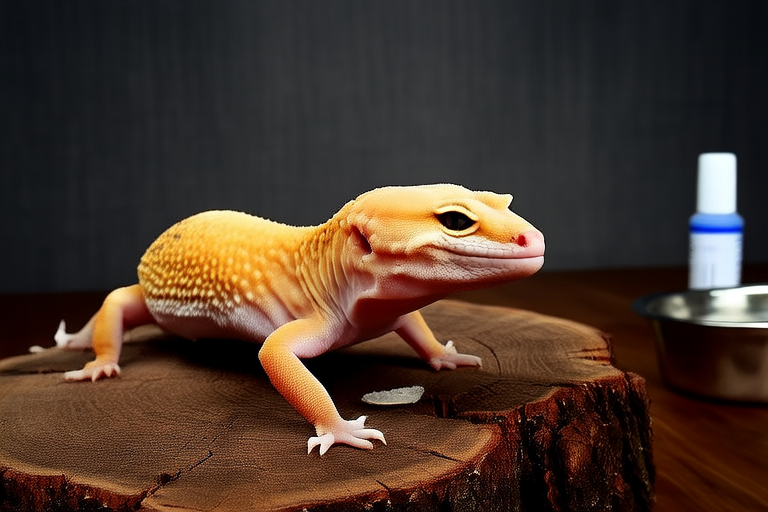Leopard Gecko Care Made Easy: Tips from Expert Pet Owners
Welcome to your comprehensive guide on how to care for a leopard gecko. Whether you’re a first-time reptile owner or looking to expand your knowledge, this article will provide you with all the necessary information to ensure your leopard gecko lives a long, healthy life.
Habitat Setup
Creating the perfect environment for your leopard gecko is crucial. Start by choosing an appropriate tank size; a 10-gallon tank is suitable for one adult gecko, while larger tanks may be needed for multiple geckos. Ensure the tank has a secure lid to prevent escapes.
- Heating: Maintain a temperature gradient of 88-96°F (31-36°C) at one end of the tank and 75-80°F (24-27°C) at the other. Use a heat mat or ceramic heat emitter for the warm side.
- Substrate: Opt for a safe substrate like paper towels, reptile carpet, or eco-friendly bedding. Avoid sand, as it can cause impaction if ingested.
- Hiding spots: Provide several hiding places to mimic natural burrows. These can be caves, half logs, or plastic containers with entry holes.
- Lighting: Leopard geckos are nocturnal, so they don’t require UVB lighting. A low-wattage red bulb can be used for night viewing without disturbing their sleep.
- Humidity: Keep humidity levels between 30-40%. Mist the tank occasionally to increase moisture, but ensure it dries out completely between mistings.
Diet Specifics
Feeding your leopard gecko correctly is vital for its health. These geckos are insectivores, meaning their diet consists primarily of insects.
- Types of food: Feed your gecko crickets, dubia roaches, or waxworms. Offer a variety of insects to ensure a balanced diet.
- Supplementation: Dust the insects with calcium powder daily and multivitamin powder twice a week. This ensures your gecko gets all the necessary nutrients.
- Feeding schedule: Feed juveniles daily and adults every other day. Adjust portions based on your gecko’s appetite and body condition.
- Water: Provide a shallow water dish that your gecko can easily access. Change the water daily to maintain hygiene.
Health Maintenance
Maintaining your leopard gecko’s health requires regular monitoring and care.
- Veterinary check-ups: Schedule annual visits to a reptile veterinarian. They can perform necessary tests and provide professional advice.
- Grooming: Clean your gecko’s enclosure weekly to prevent the buildup of bacteria and parasites. Remove uneaten insects promptly.
- Weight monitoring: Weigh your gecko monthly to track its growth and overall health. Sudden weight changes can indicate underlying issues.
- Common health issues: Watch for signs of respiratory infections, metabolic bone disease, or parasites. Early detection and treatment are key to recovery.
Behavior Insights
Understanding your leopard gecko’s behavior helps you provide better care and companionship.
- Nocturnal habits: Leopard geckos are active at night, so they might not be as interactive during the day. Nighttime activities include hunting for food and exploring their environment.
- Territoriality: While generally docile, geckos can become territorial, especially when food is involved. Always approach them gently and avoid startling them.
- Communication: Geckos communicate through body language and vocalizations. Listen for chirping sounds, which can indicate stress or excitement.
- Social interactions: Leopard geckos are solitary animals and do not require companionship. However, some geckos can coexist peacefully if introduced carefully and monitored closely.
Common Mistakes to Avoid
Avoid these common pitfalls to ensure your leopard gecko thrives.
- Incorrect temperatures: Improper heating can lead to health problems. Always use a reliable thermometer to monitor temperatures accurately.
- Inadequate supplementation: Failure to supplement food can result in nutrient deficiencies. Follow a consistent supplementation routine.
- Overfeeding: Excessive feeding can cause obesity and related health issues. Stick to the recommended feeding schedule.
- Poor hygiene: Neglecting enclosure cleaning can expose your gecko to harmful bacteria and parasites. Regular cleaning is essential.
- Handling too frequently: Overhandling can stress your gecko. Limit handling sessions to brief periods and always support their body properly.
Conclusion
Caring for a leopard gecko can be a rewarding experience. By setting up the right habitat, providing a nutritious diet, maintaining good health, understanding behavior, and avoiding common mistakes, you’ll be well-equipped to provide your gecko with a happy and healthy life. Remember, every gecko is unique, so adapt your care routine accordingly. With patience and dedication, you’ll build a strong bond with your pet and enjoy many years together.
